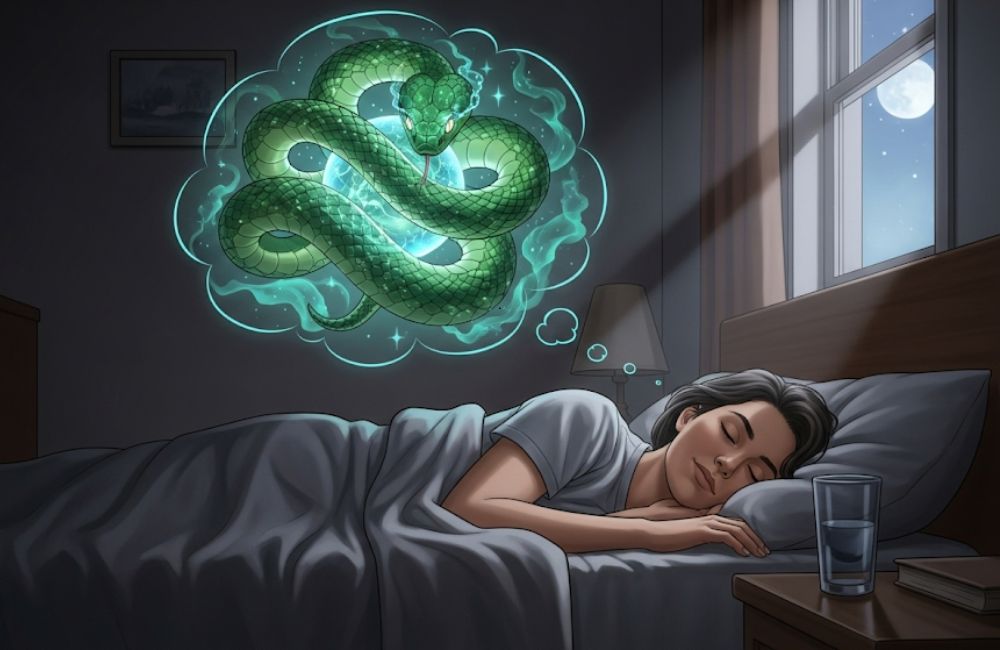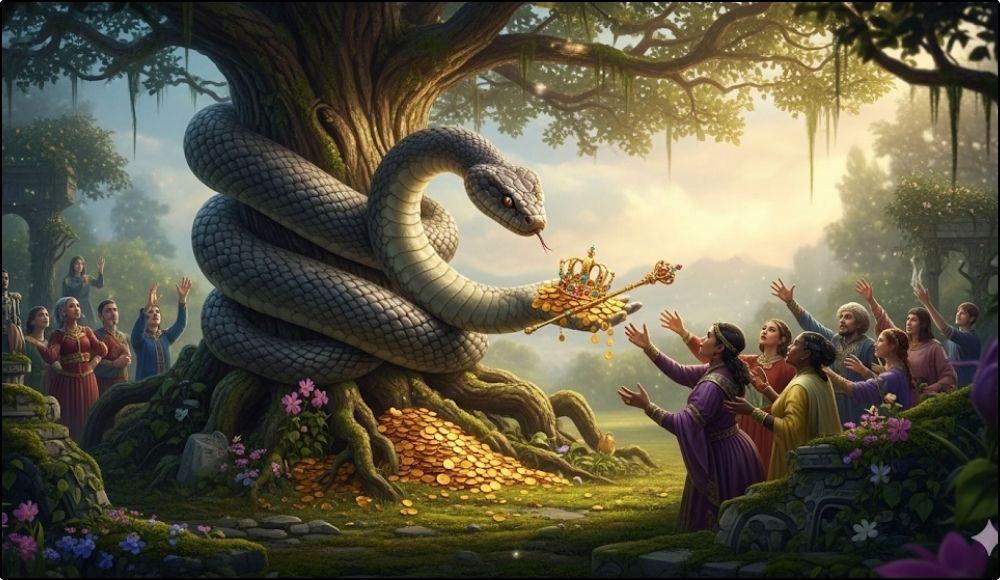Dreams are often called the “royal road to the unconscious,” as Freud once wrote. Among the countless images that appear in sleep, snakes are among the most common and the most haunting. A 2021 study in Frontiers in Psychology noted that serpents rank among the top five animals in global dream reports.
Why does this ancient creature keep visiting our dreamscapes? From biblical tales of temptation to the healing rod of Asclepius, snakes carry powerful symbolism that transcends time and culture. Exploring what it means to dream of a snake is less about superstition and more about decoding a universal language of fear, transformation, and renewal.
Each interpretation reflects the dreamer’s state of mind and life stage, making snake dreams both deeply personal and profoundly universal.
What Does It Mean to Dream of a Snake?
When a snake slithers into a dream, it rarely leaves the dreamer indifferent. In ancient Hindu mythology, snakes—nāgas—guard hidden treasures and embody the cycle of birth and rebirth. Modern dream analyst Lauri Loewenberg explains that a snake often signals “something in your life that feels threatening, toxic, or in need of transformation.”

The meaning shifts with the dream’s details: a calm snake may suggest healing, while an aggressive serpent could mirror unresolved conflict. The dream’s emotional tone is key—was the dreamer terrified, fascinated, or strangely comforted? Literature, too, reflects this ambiguity.
In D. H. Lawrence’s famous poem Snake, the encounter is at once fearful and reverent, capturing the creature’s dual symbolism of danger and wisdom. To dream of a snake is to confront what lies beneath awareness—our fears, our desires, or perhaps an invitation to shed old skin.
Symbolism of Snakes in Dreams
Snakes have carried layered meanings since time immemorial. Their ability to shed skin makes them archetypes of transformation and renewal. Carl Jung saw them as embodiments of the “shadow”—the hidden, often repressed parts of the psyche.

Yet they also signify healing: the medical caduceus entwined with serpents is a symbol recognized by the World Health Organization. A 2011 article in World Journal of Surgery traced this link back to ancient Greece. At the same time, the serpent carries menace; in Christian tradition, the snake is a deceiver, a bringer of fear.
This polarity—healing versus harm—mirrors the dualities within ourselves. In dreams, snakes can reveal whether the dreamer stands at the edge of danger or the cusp of personal rebirth. They are guardians of thresholds, reminding us that fear and growth often coil together.
Different Types of Snake Dreams and Their Meanings
The form the snake takes often shapes its meaning. A snake bite, according to dream researchers, frequently symbolizes feelings of betrayal or vulnerability. If the snake is black, it may signal fear of the unknown, echoing cultural associations of darkness with danger.

A white snake, by contrast, often points to renewal and healing, a sign of purity or spiritual transformation. When a snake wraps itself around the body, it can signify emotional entrapment—much like the suffocating python myths that appear in African folklore.
If the serpent slithers away, it might represent avoidance or a fear of facing change. The 19th-century symbolist poets often drew on serpents as metaphors for both temptation and divine knowledge, underscoring the dream’s ambiguity. Each variation carries nuance, but together they map the intimate terrain of the subconscious.
Psychological Views on Snake Dreams
Sigmund Freud interpreted snake dreams as phallic symbols, reflecting hidden sexual desires. In his 1900 masterpiece The Interpretation of Dreams, he noted that serpents often appeared in the dreams of patients grappling with intimacy.

Carl Jung, however, saw them differently—as emblems of the collective unconscious and repositories of wisdom. “The snake is a mystery,” Jung wrote, “representing both fear and the possibility of transformation.” Modern psychologists extend these views. Linda Mastrangelo, a dream specialist, argues that recurring snake dreams point to unattended areas of life demanding awareness.
Empirical studies support this: recurrent dreamers often report higher levels of stress or unresolved trauma. Thus, psychology suggests that the snake is neither good nor bad—it is a messenger, carrying coded warnings or invitations to growth from the depths of the mind.
Cultural and Spiritual Interpretations of Snake Dreams
Cultures across time have revered and feared snakes. In Hinduism, the coiled kundalini serpent at the spine represents awakening energy. In Greek myth, Asclepius, god of medicine, carried a staff entwined with a serpent—a healing symbol still seen in hospitals today.

Meanwhile, in the Book of Genesis, the serpent appears as the deceiver, luring humanity into temptation. The ouroboros, an ancient alchemical symbol of a snake eating its tail, signifies eternity and the cyclical nature of existence. These cultural echoes seep into our dreams.
A person raised with Christian imagery may see snakes as omens of evil, while someone immersed in Eastern traditions might view them as sacred guardians of wisdom. Thus, snake dreams not only reflect personal psychology but also resonate with ancestral memory and cultural myth.
What Snake Dreams Reveal About Your Life
Snake dreams often mirror real-life struggles. A venomous serpent might embody a toxic relationship, its bite echoing emotional betrayal. A shedding snake can symbolize readiness to leave behind a job, habit, or belief system. Business Insider once reported that snakes in dreams often signal unresolved fears or looming life changes.

In health contexts, some dream interpreters link snakes to the body’s natural healing process, drawing on the ancient association between serpents and medicine. For example, someone battling illness may dream of a calm snake, a subconscious image of the body’s resilience.
Mystically, the snake can act as a guide—appearing when a threshold must be crossed. These dreams remind us that life’s greatest transformations often come with discomfort, much like the skin a snake must abandon to grow.
How to Respond to Dreams of Snakes
Snake dreams are not random—they are invitations to reflection. Experts like Tzivia Gover recommend recording dreams in a journal, noting emotions, colors, and details for interpretation. If fear dominates, it may point to anxieties or relationships that need addressing.

If the snake feels peaceful, it could signify healing or inner growth. Literature and art suggest embracing the serpent as a teacher: the poet Rilke once wrote that “everything terrible is something that needs our love.” On a practical level, facing fears, setting boundaries with toxic people, or seeking professional guidance can transform the dream’s message into real-life change.
In moments when dreams recur with intensity, therapists specializing in dream work can help decode underlying trauma. In the end, responding to the dream of a snake is about listening—truly listening—to the voice of the subconscious.
Conclusion
To dream of a snake is to stand at a crossroads between fear and transformation. Across psychology, mythology, and medicine, the serpent carries a dual message: it can wound, but it can also heal. From Freud’s interpretations to Jung’s archetypes, from biblical temptation to Hindu kundalini, the snake coils through history as a mirror of humanity’s inner struggles.
Each dream is deeply personal, shaped by culture, memory, and emotion. Yet one truth remains: when the serpent slithers into the night, it is asking us to pay attention. Perhaps it warns of danger, or perhaps it invites rebirth. Either way, to confront the snake is to confront ourselves—and to emerge, like the serpent itself, renewed.





